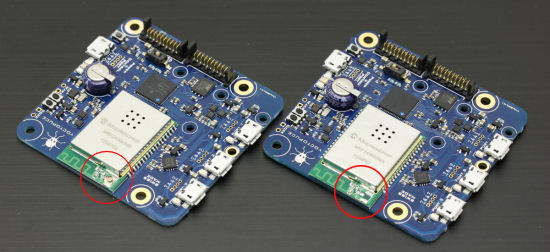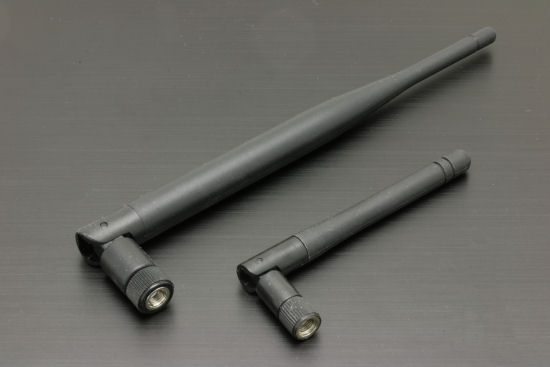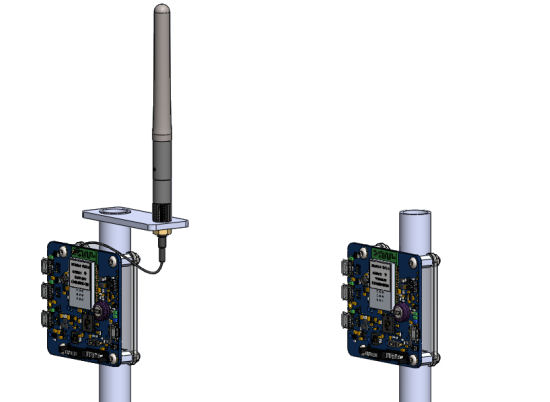![]() This week we are happy to introduce the YoctoHub-Wireless-SR. This device is almost the same as the YoctoHub-Wireless, except for the antenna: this YoctoHub uses an onboard PCB antenna rather than an external antenna. Of course, this does not provide the same performances. We have therefore decided to run a small Wi-Fi range testing session with various antennas.
This week we are happy to introduce the YoctoHub-Wireless-SR. This device is almost the same as the YoctoHub-Wireless, except for the antenna: this YoctoHub uses an onboard PCB antenna rather than an external antenna. Of course, this does not provide the same performances. We have therefore decided to run a small Wi-Fi range testing session with various antennas.

Here is the YoctoHub-Wireless-SR
The YoctoHub-Wireless-SR does not require an external antenna because it features a built-in antenna, printed directly on its PCB. If you look carefully at the network adapter soldered on the device, you will see that instead of the uFL antenna connector, there are a few extra components that activate a zig-zag PCB trace. This trace is the antenna.

The only difference between a YoctoHub-Wireless and a YoctoHub-Wireless-SR
Although it is obvious that using such a small antenna will not provide the same link quality, we had to better know how large the impact would be. To evaluate that, we have made a little real-scale experiment. We also took that opportunity to test a pair of high-gain antenna.

A high-gain antenna (8dBi) next to the standard YoctoHub-Wireless antenna (2dBi)
To perform these tests, we have used a PoE Netgear ProSafe WG103 wireless access point. The YoctoHub-Wireless-SR and the YoctoHub-Wireless have been attached to a PVC pole at approximatively 1m25 from the ground. We have performed the range tests by moving the pole with the YoctoHubs further and further away.

The YoctoHub-Wireless have been mounted on a PVC pole
During each test, we turn on the YoctoHub and attempt to ping the server pool.ntp.org. In order to do so, the device will have to acquire an IP address by DHCP and resolve the hostname using DNS. The test is considered a success if we have at least three consecutive ping going through. Indeed, a TCP connection is expected to be at least as robust as this simple packet exchange.
We have run the same tests using three configurations:
- a YoctoHub-Wireless-SR and a standard access point
- a standard YoctoHub-Wireless and a standard access point
- a YoctoHub-Wireless and an access point both equipped with high-gain 8dBi antennas (TP-Link TL-ANT2408C, found in the nearest IT store)
First important point: the key to a good wireless link is a clear line of sight. In order to get the longest possible range, it should be possible to see the access point antenna from the YoctoHub antenna. Any obstacle, whether fence or a tree, will dramatically reduce the wireless range. Beyond 250m, we had to place the hubs at around 3m height to secure a clear path between the antennas. Our experience has also shown that the orientation of the YoctoHub-Wireless-SR that provides the best results is when the device PCB plane is aligned with the access point antenna.

The YoctoHub-Wireless-SR provides the best results when the board and the access point antenna are on the same plane
To evaluate the link quality, we have used the indicator provided by the device (which is based on the RSSI). It is not a very reliable measure, but rather a qualitative indicator. Below 45%, the performance of the communication link is significatively reduced. Below 40%, the YoctoHub can still see the network but cannot anymore establish a reliable communication channel. Here is the graph of the measures that we have obtained.

The results of our experiment
The first result of this experiment is a honorable performance for the YoctoHub-Wireless-SR, with up to 230m with a clear line of sight. Keep in mind however that for some applications, the YoctoHub-Wireless-SR might be further hindered:
- This test was run without enclosure. As the antenna is embedded on the PCB, an enclosure will have an influence on the link quality.
- The YoctoHubs have both been put at the same place, with a clear view of the access point. In a real-life application, it might be easier to get a line of sight using a YoctoHub-Wireless since its antenna can be moved further away.
- Depending on the application, other modules connected to the YoctoHub might affect the link quality of the YoctoHub-Wireless-SR, since the antenna cannot be moved away.
The second lesson from this experiment is that when a long range is desirable, antenna really matters. No real surprise here, but the difference is spectacular. Using a simple omnidirectional 8dBi antenna made it possible to double our Wi-Fi range compared to a standard antenna. It is likely that even longer ranges could be obtained using a pair of directional antennas. Here in Switzerland, such antennas can easily be found with a gain of 20dBi. But be aware that a directional antenna is not as easy to put in place as an omnidirectional antenna.
Last but not least, be aware that the use of high-gain antenna is forbidden in some countries.
Further readings: Microchip, the manufacturer of the Wi-Fi component used in the YoctoHubs, has edited a very interesting application note including indoor and outdoor Wi-Fi tests, as well as ideas on how to take obstacles into consideration.


